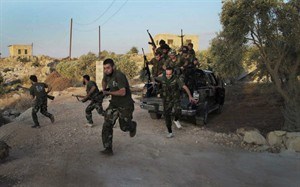
In this citizen journalism image taken on Friday, July 13, 2012 and provided by Edlib News Network ENN, Free Syrian Army soldiers run for cover in Idlib province, northern Syria. (AP Photo/Edlib News Network ENN) THE ASSOCIATED PRESS IS UNABLE TO INDEPENDENTLY VERIFY THE AUTHENTICITY, CONTENT, LOCATION OR DATE OF THIS HANDOUT PHOTO
July 16, 2012 - 10:17 AM
BEIRUT - Syrian troops and rebels clashed inside Damascus for a second day on Monday, causing plumes of black smoke to drift over the city's skyline in some of the worst violence in the tightly controlled capital since the country's crisis began 16 months ago.
The fighting briefly closed the highway linking the capital with Damascus International Airport to the city's south — an unprecedented development, said Mustafa Osso, an activist based in Syria.
"It seems there is a new strategy to bring the fighting into the centre of the capital," Osso told The Associated Press, referring to the rebels who fight under the banner of the Free Syrian Army. "The capital used to be safe. This will trouble the regime."
The violence in Syria has grown increasingly bloody and chaotic in recent months as the uprising has morphed from a peaceful revolt into an armed insurgency aimed at toppling President Bashar Assad's regime.
In Moscow, Russian Foreign Minister Sergey Lavrov accused the West of using blackmail to secure a new U.N. Security Council resolution that could allow the use of force in Syria. A Chapter 7 resolution authorizes actions to enforce sanctions that can ultimately include the use of military force, which U.S. administration and European officials — for now — are playing down as a possibility.
U.N. special envoy Kofi Annan was expected in Moscow to discuss the Syria crisis with Russian leaders on Monday. The meeting — the latest in Annan's efforts to save his faltering peace plan — comes a day after the conflict crossed an important symbolic threshold, with the international Red Cross formally declaring it a civil war, a status with implications for potential war crimes prosecutions.
Monday's fighting in Damascus was concentrated in the neighbourhoods of Kfar Souseh, Midan and Tadamon, according to Osso and the Britain-based Syrian Observatory for Human Rights. The Observatory said there were casualties but did not provide a number.
An amateur video posted online showed several gunmen, some of them masked, as they ran or opened fire in the streets of Tadamon. Other gunmen took positions behind sand bag fortifications and fired toward areas where government forces were said to be taking positions.
Another video showed Kfar Souseh with the sound of intense gunfire in the distance. The presidential palace, on a mountain overlooking the capital, could be seen in the background.
The authenticity of the videos could not be independently confirmed.
There have been sporadic clashes in Damascus in recent months, although President Bashar Assad's forces remain firmly in control of the city. Many of the Damascus suburbs, however, have risen up against the regime, prompting a ferocious response from the military in an attempt to clear out rebel fighters from the towns that ring the capital.
On Monday, activists reported government attacks in the Damascus suburb of Qatana.
Rami Abdul-Rahman, who heads the Observatory, said Monday's fighting was taking place about 2 kilometres (1 mile) from the airport highway.
A Damascus resident who spoke on condition of anonymity for fear of reprisals said gunfire and sporadic explosions could be heard throughout the morning. The resident said that unlike previous clashes that occurred at night, the recent fighting took place during the day — a sign that the rebels are becoming more brazen.
Another resident said black smokes could be seen all over Damascus since Sunday. The resident added that shooting and bombing can be heard in Damascus and that security forces deployed along the army all areas in the city.
"People are fleeing from Midan and Tadamon," the resident said. "It is the most serious clashes in Damascus."
The Syrian regime has grown increasingly isolated as it has ramped up its offensive against the opposition, and several Western and Arab nations have either expelled Syrian diplomats or pulled their own ambassadors from Damascus to protest the crackdown.
On Monday, Morocco asked the Syrian ambassador to leave the country, Moroccan Communications Minister Mustapha Khalfi told The Associated Press. Within hours, Syria's state-run TV said the Foreign Ministry declared Morocco's ambassador to Syria persona non grata.
Tunisia was the first Arab country to withdraw its ambassador from Syria in February to protest the harsh crackdown on the opposition and it was followed shortly by the six nations of the Gulf Cooperation Council.
On Sunday, United Nations observers gathered new details on what happened in a village where dozens were reported killed in a regime assault. After a second visit to Tremseh on Sunday, the team said Syrian troops went door-to-door in the small farming community, checking residents' IDs and then killing some and hauling others away.
According to the U.N., the attack appeared to target army defectors and activists.
"Pools of blood and brain matter were observed in a number of homes," a U.N. statement said.
Syria denied U.N. claims that government forces had used heavy weapons such as tanks, artillery and helicopters during the attack Thursday.
Anti-regime activists estimate that more than 17,000 people have been killed in Syria since the uprising began.
News from © The Associated Press, 2012